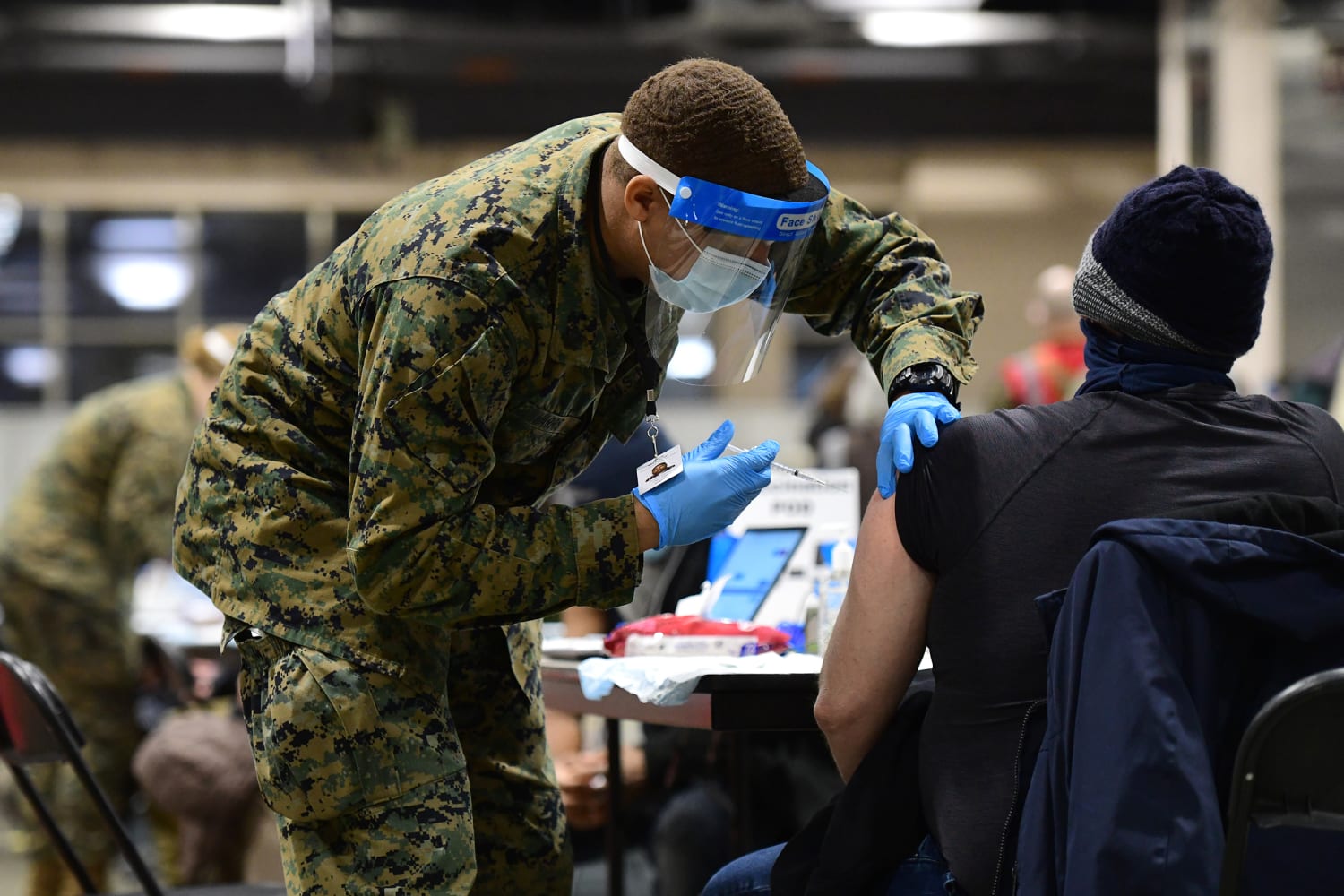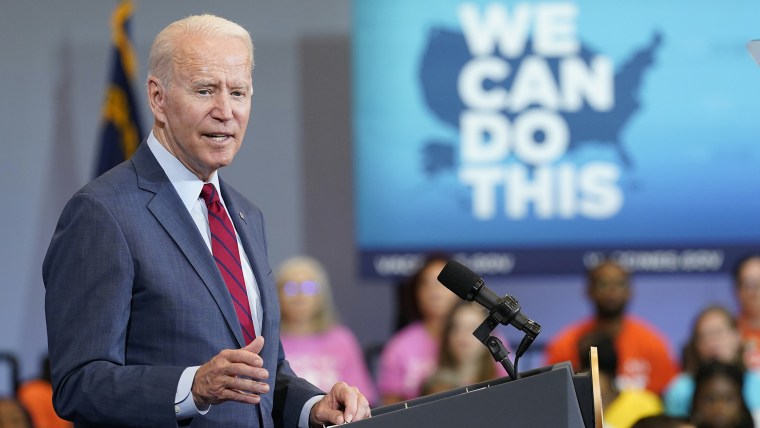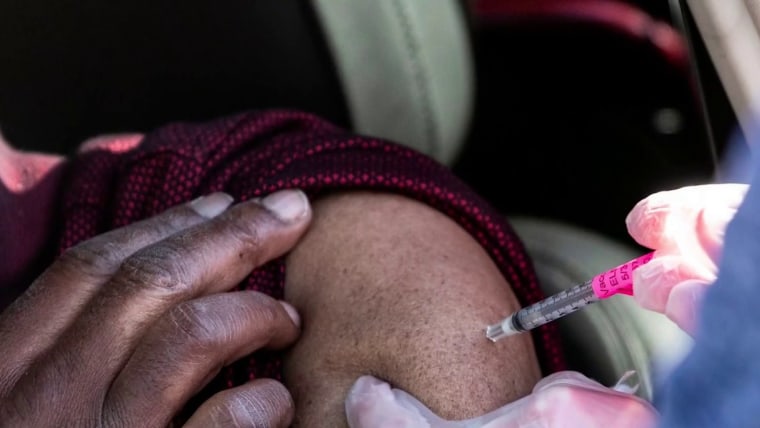WASHINGTON — Nearly three out of every four shots administered at the federal government’s Covid vaccination center in Cleveland went into white arms, according to site-by-site data provided exclusively to NBC News by the Federal Emergency Management Agency.
That compares to a city-wide population that is 33.8 percent non-Hispanic white. At the same time, Black people were given just 10.8 percent of the shots, despite accounting for nearly half of Cleveland’s residents. And, in figures that comport with broader national vaccination trends, Asian Americans got shots at a higher rate — and Hispanic people at a lower rate — than their share of the local population.
The full data set, covering 39 federal Community Vaccination Centers in 27 states, suggests President Joe Biden met his promise to “fight this virus with equity” in some parts of the country but not others. Where the administration fell short, it was not for lack of effort: Both political appointees and career officials at federal agencies say that equity was the watchword of the program.
“During the mission, our intentional, evidenced-based and consistent decision-making advanced equity,” FEMA Administrator Deanne Criswell said in a statement to NBC News. “We moved fast to deliver vaccines to underserved communities in collaboration with our federal, state, local, territorial and tribal nation partners. Our country is in a better place now because of it, especially as we continue to support our partners in their localized efforts to increase vaccination levels.”
Overall, federally managed vaccination centers delivered 5.6 million shots between mid-February and July 5, when the program ended, according to FEMA’s records. The agency was only able to track demographic data for the recipients of 81.4 percent of the doses, leaving a major hole in the picture of the efficacy of the equity push. In addition, FEMA officials said, the agency was not able to ascertain how many of the doses were one-time Johnson and Johnson vaccinations and how many were first or second doses of the Pfizer and Moderna vaccines.
Of the 4.6 million doses delivered to people whose race or ethnicity was reported, 41.9 percent were given to non-Hispanic whites, 25.5 percent were administered to Hispanic people and 14.7 percent went to Black people. Asian Americans accounted for 13.9 percent, 3.6 percent went to people who identified as multiracial or checked “other” on their forms, and half a percent went to Native Americans, Native Alaskans and Pacific Islanders.
The Census Bureau reported earlier this month that non-Hispanic whites make up 57.8 percent of the U.S. population. Hispanic people account for 18.7 percent, and Black people constitute 12.1 percent of the population, according to the 2020 census.
The federal vaccination centers were set up to supplement state-run operations by making shots more readily available to the most socially vulnerable populations. The risk of severe illness or death from Covid is greater in certain communities of color — including among Black and Hispanic populations — because of disparities in the health system, according to the Centers for Disease Control and Prevention.
While the share of vaccine doses administered to people of color at federal centers across the country exceeded their shares of the U.S. population, the skew had little effect on the overall vaccination demographics across the country because the federal centers accounted for such a small proportion of all the shots delivered. The program was designed specifically to reach minority communities, in part by locating centers in areas where they were most likely to reach people of color, focusing on advertising campaigns on communities of color and tailoring programs in different states to reach a diverse array of communities.
“What are we willing to do to make sure that the most vulnerable populations and underserved populations are served first?” one FEMA official said of the questions at the center of the federal vaccination center push. “What are we willing to do to make sure that we’re taking care of those communities?”
Beatriz Amberman, chair of the Virginia Coalition of Latino Organizations, praised the Biden administration for consulting with local leaders such as herself when FEMA opened its vaccination program in her state.
She recommended several steps the state government had not taken, including allowing patients to receive shots without pre-registering for appointments and without providing more than their own name and contact information for someone who could reach them in case of an adverse reaction to the vaccine. FEMA’s targeted engagement with the Latino community helped alter the state’s approach, Amberman said in an interview with NBC News.
“It was after FEMA came to the area and modeled that system,” she said. “That helped ease the concerns of the state. After FEMA left, the state was convinced by the results that was the way to go.”
Virginia’s federal vaccination program, centered at Norfolk’s Military Center Mall, administered 87,333 shots beginning on the last day of March. The demographic data for that location is more precise than for most of the centers, with race and ethnicity of the patient identified for 92.7 percent of the shots given.
Fifty-four percent of those doses went to people of color, according to FEMA’s data, including 31.1 percent to African Americans, 10.1 percent to Hispanic people and 8.4 percent to Asian Americans. Norfolk’s population is 43.4 percent non-Hispanic white, and 45.1 percent of the shots went to whites.
At the very first federal vaccination center, opened in Oakland, Calif., February 16, FEMA reported providing 59.2 percent of doses to people of color, compared to a metro-area population that is 71.7 percent nonwhite. Whites accounted for 40.1 percent of the vaccinations.
Like many of its counterparts, the Oakland program used a “hub and spokes” model — with a central site at the Oakland Coliseum and smaller clinics around the region to reach out into communities — according to AmeriCorps workers who helped manage the effort. That included engaging with churches and nonprofit organizations to find people to vaccinate, a process that largely failed to achieve equity for the Black and Hispanic communities in Oakland.
Officials on the ground in Oakland were surprised to hear that Asian Americans accounted for nearly 30 percent of vaccinations in the city’s federal vaccination program — about double their share of the population — while Black people, at 6 percent, and Hispanic people, at 19.7 percent, were far below their respective shares of 23.8 percent and 27 percent of city residents.
“We went into communities that didn’t have access and couldn’t get their population to the big hub,” said Parth Singh, one of the AmeriCorps workers. “We didn’t have visibility into any of the big data that was being accumulated.”
FEMA chose its sites first by descending order of state population, starting with California, Texas, Florida and New York, and worked with state officials to identify precise locations. To find spots where equity could be prioritized, the agency used the Centers for Disease Control and Prevention’s social vulnerability index, a measure that ranks susceptibility to health disadvantage on a county-by-county basis.
When then-New York Gov. Andrew Cuomo protested the decision to put a site in rural white Chautauqua County, a sparsely populated expanse in Western New York, FEMA adjusted its process to take into account the social vulnerability of clusters of census blocks. New York ended up with six vaccination centers, including upstate locations in Yonkers, Albany, Buffalo and Rochester. At the time, Cuomo was planning to seek re-election, and all four of the locations were more hospitable to his brand of Democratic politics than heavily Republican Chautauqua County.
In Albany, 73.4 percent of shots for which the patient’s demographic data was available went to non-Hispanic whites. In Buffalo, that figure was 63 percent, and in Rochester it was 61.7 percent.
However, a handful of mega-sites stood out for their comparatively high number and share of nonwhites vaccinated. In Los Angeles, where 322,570 doses of vaccine were distributed, 27.8 percent went into white arms — a bit lower than the city-wide percentage of 28.5 percent. That site, located at Cal State University’s campus in the city, gave more shots than any other pilot CVC.
At the New Jersey Institute of Technology’s Wellness and Events Center in Newark, just 16.8 percent of nearly 286,000 shots were administered to whites, compared to a city-wide population that is 11 percent non-Hispanic white.
The FEMA official said community engagement was an outgrowth of trying to figure out how to reach the most vulnerable populations — and those least likely to have easy access to shots.
“Our whole-of-government and whole-of-community approach both achieved results and served as a generator of best practices at every level,” Criswell said. “At FEMA, we’re leveraging this experience to ensure we continue to equitably deliver our programs and assistance.”
She also acknowledged her agency can do more to reach under-served communities.
“Systemic issues require systemic change,” Criswell said. “FEMA is committed to strengthening how we serve survivors who face unique barriers before, during and after disasters.”
Source: | This article originally belongs to Nbcnews.com












